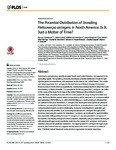Use este identificador para citar ou linkar para este item:
http://www.alice.cnptia.embrapa.br/alice/handle/doc/1035996Registro completo de metadados
| Campo DC | Valor | Idioma |
|---|---|---|
| dc.contributor.author | KRITICOS, D. J. | pt_BR |
| dc.contributor.author | OTA, N. | pt_BR |
| dc.contributor.author | HUTCHISON, W. D. | pt_BR |
| dc.contributor.author | BEDDOW, J. | pt_BR |
| dc.contributor.author | WALSH, T. | pt_BR |
| dc.contributor.author | TAY, W. T. | pt_BR |
| dc.contributor.author | BORCHERT, D. M. | pt_BR |
| dc.contributor.author | MORAES, S. V. de P. | pt_BR |
| dc.contributor.author | CZEPAK, C. | pt_BR |
| dc.contributor.author | ZALUCKI, M. P. | pt_BR |
| dc.date.accessioned | 2016-02-03T11:11:11Z | pt_BR |
| dc.date.available | 2016-02-03T11:11:11Z | pt_BR |
| dc.date.created | 2016-02-03 | pt_BR |
| dc.date.issued | 2015 | pt_BR |
| dc.identifier.citation | Plos One, San Francisco, v. 10, n. 3, p. 1-24, March 2015. | pt_BR |
| dc.identifier.uri | http://www.alice.cnptia.embrapa.br/alice/handle/doc/1035996 | pt_BR |
| dc.description | Helicoverpa armigera has recently invaded South and Central America, and appears to be spreading rapidly. We update a previously developed potential distribution model to highlight the global invasion threat, with emphasis on the risks to the United States. The continued range expansion of H. armigera in Central America is likely to change the invasion threat it poses to North America qualitatively, making natural dispersal from either the Caribbean islands or Mexico feasible. To characterise the threat posed by H. armigera, we collated the value of the major host crops in the United States growing within its modelled potential range, including that area where it could expand its range during favourable seasons. We found that the annual value of crops that would be exposed to H. armigera totalled approximately US$ 78 billion p.a., with US$ 843 million p.a. worth growing in climates that are optimal for the pest. Elsewhere, H. armigera has developed broad-spectrum pesticide resistance; meaning that if it invades the United States, protecting these crops from significant production impacts could be challenging. It may be cost-effective to undertake preemptive biosecurity activities such as slowing the spread of H. armigera throughout the Americas, improving the system for detecting H. armigera, and methods for rapid identification, especially distinguishing between H. armigera, H. zea and potential H. armigera x H. zea hybrids. Developing biological control programs, especially using inundative techniques with entomopathogens and parasitoids could slow the spread of H. armigera, and reduce selective pressure for pesticide resistance. The rapid spread of H. armigera through South America into Central America suggests that its spread into North America is a matter of time. The likely natural dispersal routes preclude aggressive incursion responses, emphasizing the value of preparatory communication with agricultural producers in areas suitable for invasion by H. armigera. | pt_BR |
| dc.language.iso | eng | eng |
| dc.rights | openAccess | eng |
| dc.subject | Armadilha de luz | pt_BR |
| dc.subject | América do Norte | pt_BR |
| dc.subject | Insecticide resistence | pt_BR |
| dc.title | The potential distribution of invading Helicoverpa armigera in North America: Is it just a matter of time? | pt_BR |
| dc.type | Artigo de periódico | pt_BR |
| dc.date.updated | 2016-02-25T11:11:11Z | pt_BR |
| dc.subject.thesagro | Lepidoptero | pt_BR |
| dc.subject.thesagro | Resistência a pesticida | pt_BR |
| dc.subject.thesagro | Planta hospedeira | pt_BR |
| dc.subject.nalthesaurus | Helicoverpa armigera | pt_BR |
| dc.subject.nalthesaurus | Lepidoptera | pt_BR |
| dc.subject.nalthesaurus | Host plants | pt_BR |
| dc.subject.nalthesaurus | Light traps | pt_BR |
| dc.subject.nalthesaurus | North America | pt_BR |
| riaa.ainfo.id | 1035996 | pt_BR |
| riaa.ainfo.lastupdate | 2016-02-25 | pt_BR |
| dc.identifier.doi | 10.1371/journal.pone.0119618 | pt_BR |
| dc.contributor.institution | DARREN J. KRITICOS, CSIRO; NOBORU OTA, CSIRO; WILLIAM D. HUTCHISON, UNIVERSITY OF MINNESOTA; JASON BEDDOW, UNIVERSITY OF MINNESOTA; TOM WALSH, CSIRO; WEE TEK TAY, CSIRO; DANIEL M. BORCHERT; SILVANA VIEIRA DE PAULA MORAES, CPAC; CECÍLIA CZEPAK, UFG; MYRON P. ZALUCKI, UNIVERSITY OF QUEENSLAND. | pt_BR |
| Aparece nas coleções: | Artigo em periódico indexado (CPAC)  | |
Arquivos associados a este item:
| Arquivo | Descrição | Tamanho | Formato | |
|---|---|---|---|---|
| 35142.pdf | 7,22 MB | Adobe PDF |  Visualizar/Abrir |









